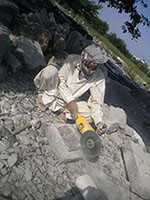Silicosis, a 21st century scourge from the remote past : between medicine, business and politics
Silicosis is, if one dare say, one of the most promising social and environmental diseases of the 21st century. It can only progress at fast pace, in relationship with the industrialization of emerging countries.

Silicosis has become a global burden, and leads to new forms of mobilization against occupational and environmental hazards caused by so-called “industrial diseases”. Defined as a progressive scarring of lungs due to inhalation of crystalline silica dust over a long period of time), it is by no way an out-of-date disease, a pathology from the remote past when America, Europe and Australia depended on coal to deliver energy to their factories and heating to their citizens.
Les risques liés à la silice
Silica being the main mineral component of the earth crust, it is an almost universal risk, which is also suspected to bring about severe chronic diseases, and is considered carcinogen by the International Agency for Research on Cancer, but not by the European Union, where producers’ unions implement an active lobbying.

La prise en compte de la silicose
Understanding the balance of power around this terrible disease, which is both massive by the number of workers affected, and cruel by its painful, incurable and often lethal effects, requires to go back to history. Occupational dust hazards have been extremely difficult for medicine to consider. They were, in a way, too universal to become visible. Although medical observations on miners’ diseases had been numerous since the Middle Ages, the pathogenic power of dust was only identified in 19th medicine. From the start this recognition was not only scientific but involved political stakes. While worker movements demanded their diseases to be compensated by the employers, industry used any blurring factors to minimize or even negate the very existence of occupational hazards. In this battle, the discovery of the tuberculosis bacillus in the 1880s acted as a surprising slowing factor. TB was used by employers’ medical experts to attribute workers’ lung diseases to their “private” habits – as is smoking nowadays. As the book tells, it then took half a century for “silicosis” and a transnational crusade to become a disease on its own, internationally recognized, and compensated for having an occupational origin.
Silica hazards, though, have never been fully recognized. Legislation has remained weak and its implementation has always been questioned. To a wide extent, legal and health regulations on silicosis were born in an imperial and racial context, that of the South African gold mines at the eve of the 20th century. Since then, the industry has used comparable means in the “first world” and in emerging countries to circumvent regulations, as well as under the most varied political regimes: liberal democracies with a private mining sector (USA, Australia) or a nationalized one (UK, France), socialist countries under Soviet rule, corporatist dictatorships.
Source: Silicosis. A World History, Paul-André Rosental, Johns Hopkins University Press, 2017
Contact: Paul-André Rosental
Online: September 2017
